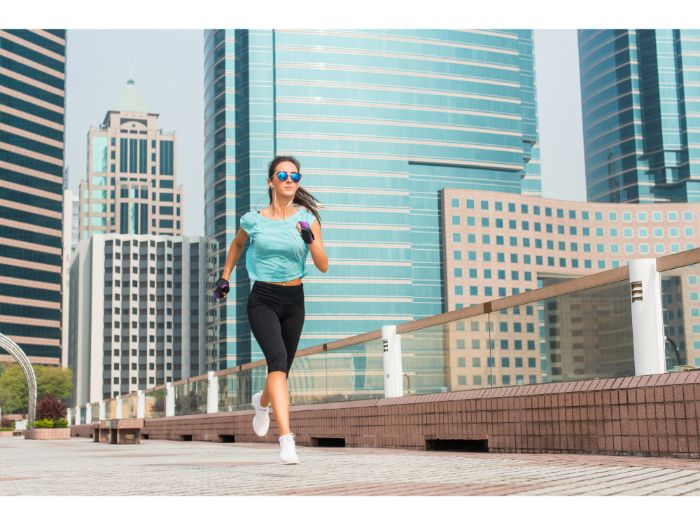What Is the Average Jogging Speed
This page contains affiliate links. As an Amazon Associate I earn from qualifying purchases.
As a general rule, the average speed of a jogger is between 4 and 6 miles per hour. A jogger moves faster than a walker but slower than a runner. If you are jogging, you may need to take a breather before having a complete conversation with your partner.
If you are more inclined to walk, jogging is an excellent way for you to challenge yourself. Moreover, jogging can prepare you for running. Regular jogging, however, can be enough to keep you physically fit.
Running is more intense and faster than jogging. There is a significant difference in pace and effort. The speed of jogging is typically 4 to 6 miles per hour (mph), while the speed of running is generally 6 mph or more.
Quick Navigation
During Jogging, How Should You Feel?
It is usually more effort-intensive to jog than walk, and the pace should be faster. While you’re in motion, you won’t be able to say more than a few words. However, each person will experience this differently. Physical fitness and strength play a role.
Running on a Treadmill Versus Running Outside
Jogging on a treadmill is easier. You don’t need to worry about air resistance since the belt moves your body. You won’t have to work against extra force indoors because the air resistance is lower. It is possible to move at a pace of 4 to 6 mph on a treadmill without exerting yourself as much as you would outdoors.
Both treadmill and outdoor jogging have their advantages, depending on your needs. They are both excellent cardiovascular exercises. And believe it or not, even your heart tells you what pace to run at.
Using Heart Rate to Calculate Jogging Speed
You can use your heart rate to determine what speed to run at on average. One minute’s heart rate is calculated as the number of beats in one minute. This is how intense your workout is. Exercise harder, and your heart rate will increase. Working muscles require more blood and oxygen because your heart pumps more blood.
You should increase your heart rate by a certain percentage based on the type of workout you want. You call this your target heart rate.
You should aim to achieve vigorous intensity by maintaining a heart rate between 70 and 85 percent of your maximum heart rate. This is the heart rate zone you should aim for.
Calculating Your Target Heart Rate Zone
Heart rate zones have upper and lower limits. If you want to calculate your maximum heart rate, you will need to subtract your age from 220. An individual aged 35 has a maximum heart rate of 220 minutes minus 35, or 185 beats per minute.
Those who want to exercise hard enough to reach the jogging zone should raise their heart rate to 70 to 85 percent of 185 beats per minute. That comes out to 130 to 157 beats per minute.

Improve Your Jogging Experience
When it comes to jogging or improving your jogging speed, here are a few things to keep in mind:
- Consult your doctor. Ask your doctor before you start running if you haven’t exercised in a long time. Having a chronic disease or a healing injury makes this even more critical. Ask your doctor how to start an exercise regimen safely.
- Start by warming up and cooling down. Start your run with a 5- to 10-minute warmup. Walking will help circulate your blood and warm up your muscles. Another option is to do jumping jacks or arm circles. Walk and stretch slowly after jogging. Using these methods will ensure that your performance is optimized.
- Make sure you start slowly. It’s best not to increase the intensity of your workout suddenly. A walking routine is an excellent place to start if you’re new to exercising. Then you can move on to jogging once you’ve gotten the hang of walking. It is also possible to alternate between walking and running during a single workout. It is possible to gradually increase your time jogging as you become stronger.
- Make sure you pay attention to your form. Do not tighten the muscles in your body by keeping your torso straight. Slightly lean forward without hunching your back. Take a moment to relax your hands, arms, and shoulders. Swing your arms from your shoulders.
- Make sure you drink plenty of water. Keeping your body hydrated is essential. When you exercise and sweat, you lose fluids from your body. It would be best if you stay hydrated at all times, before, during, and after your jogging session. It is even more important to drink more water in humid and hot weather.
- Make sure you use the right workout gear when you go to the gym. You must wear comfortable and supportive shoes. It would be a good idea to go to a store to try on athletic shoes. Make sure you do not wear old or worn-out gym shoes as these can increase the risk of injury and pain. You can also consider wearing lightweight, breathable clothing to make your workouts more comfortable.
You can get the most out of your jog if you follow these tips. Consult a personal trainer if you need additional guidance. Your trainer can provide you with jogging tips tailored to your age, fitness level, and goals.
More on Treadmills
Beginner treadmill runners should walk less than 5km/h. Beginners should do jogging at a speed of 8.5km/h (5 mph), while anything over7.5km/h is considered running. You can walk, jog, run, or jog on a treadmill. Running can be done in the same place, and running can be stopped whenever you feel like stopping.
You can lose weight by doing cardio exercises every day on a treadmill. You must be disciplined, consistent, and motivated to keep your stomach flat. As desired, a treadmill can be used for walking, jogging, or running. Additionally, you can do it while still standing at the same spot and stop whenever you feel exhausted.
Final Thoughts
Knowing the average jogging speed doesn’t really impact what you are doing. However, it is interesting to know these figures if you are looking to monitor whether you are jogging or running.



